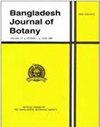Genotype and environment interactions of yield contributing characters of field mustard (Brassica rapa L.)
IF 0.3
4区 生物学
Q4 PLANT SCIENCES
引用次数: 0
Abstract
Genotype-environment interaction is the norm of reciprocal action that determines the relationship between gene and environmental factors. Gene and environment interaction takes place when different environments affect the genotypes and vice versa. The investigation portrays the interaction between genes and environments of yield contributing characteristics of eleven genotypes of field mustard. Three seeding-time environments, viz., early, late, and very late of eleven mustard genotypes were laid out with three replications in a randomized complete block design. Among the three environments, which one was favorable and which was not was determined by their significant differences through a combined analysis of variance. The IPCA 1 (first interaction principal component axis) score of genotypes in the AMMI (additive main effects and multiplicative interaction analysis) of G×E interactions was estimated as an indication of the ability to respond to the environments and the performance with changing environments of the genotypes. Considering all the scores, Sonali Sharisha (SS-75), and BINA Sharisha-10 were found to be highly stable genotypes, while among the three environments, the environment-1 (early sowing) was found the best sowing time for raising and harvesting a good mustard crop. Bangladesh J. Bot. 52(4): 1055-1065, 2023 (December)大田芥菜(Brassica rapa L.)产量贡献特征的基因型与环境交互作用
基因型与环境之间的相互作用是决定基因与环境因素之间关系的互作准则。当不同的环境影响基因型时,基因与环境就会发生相互作用,反之亦然。本研究描述了 11 个大田芥菜基因型的产量贡献特性的基因与环境之间的相互作用。11 个芥菜基因型的三种播种时间环境,即早播、晚播和极晚播,在随机完全区组设计中进行了三次重复。在这三种环境中,哪种环境有利,哪种环境不利,是通过综合方差分析确定的。在 G×E 交互作用的 AMMI(加法主效应和乘法交互作用分析)中,对基因型的 IPCA 1(第一交互作用主成分轴)得分进行了估算,以表明基因型对环境的反应能力以及在环境变化时的表现。考虑到所有得分,Sonali Sharisha(SS-75)和 BINA Sharisha-10 被认为是高度稳定的基因型,而在三种环境中,环境-1(早播)被认为是培育和收获良好芥菜作物的最佳播种时间。孟加拉国植物学杂志52(4):1055-1065,2023 年(12 月)
本文章由计算机程序翻译,如有差异,请以英文原文为准。
求助全文
约1分钟内获得全文
求助全文
来源期刊

Bangladesh Journal of Botany
生物-植物科学
CiteScore
0.80
自引率
0.00%
发文量
77
审稿时长
9 months
期刊介绍:
Bangladesh in situated on the north of Bay of Bengal. Climatically it is a humid subtropical country. Most of the land is deltaic plain of two great rivers, the Ganges and the Bhrammaputra and it tributaries. The country has rich diversity of plants. Main crops cultivated are Rice, Jute, Wheat, Maize, Sugarcane, Mustard and different kinds of Lentils. There are a good number of Public and Private Universities and Plant Research Establishments.
Bangladesh Journal of Botany is the official organ of the Bangladesh Botanical Society established in 1972. Since 1972 Bangladesh Journal of Botany is being published regularly. Two issues of the Journal are published, one in June and another in December.
Scientific papers (Full paper and short communication) on any field of Plant Sciences from anywhere in the World are considered for publication in Bangladesh Journal of Botany.
 求助内容:
求助内容: 应助结果提醒方式:
应助结果提醒方式:


